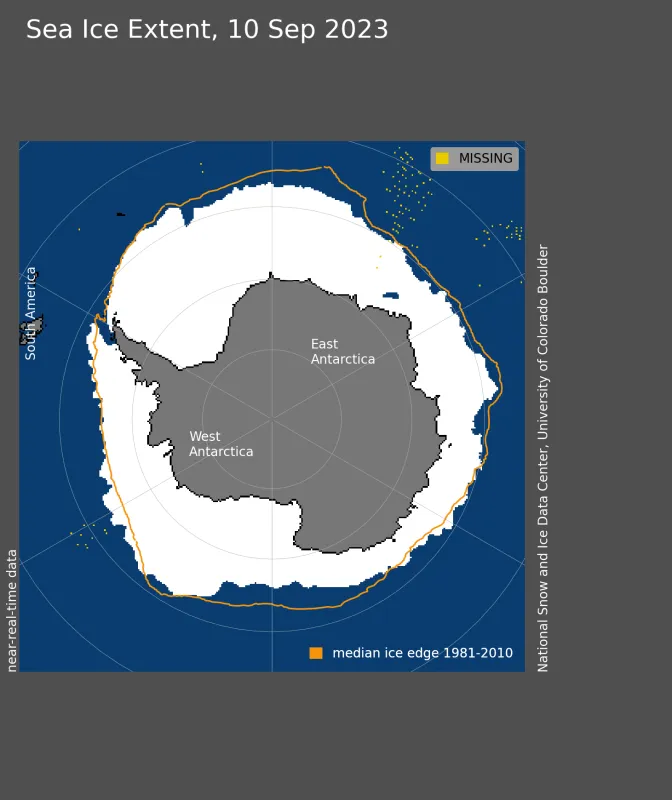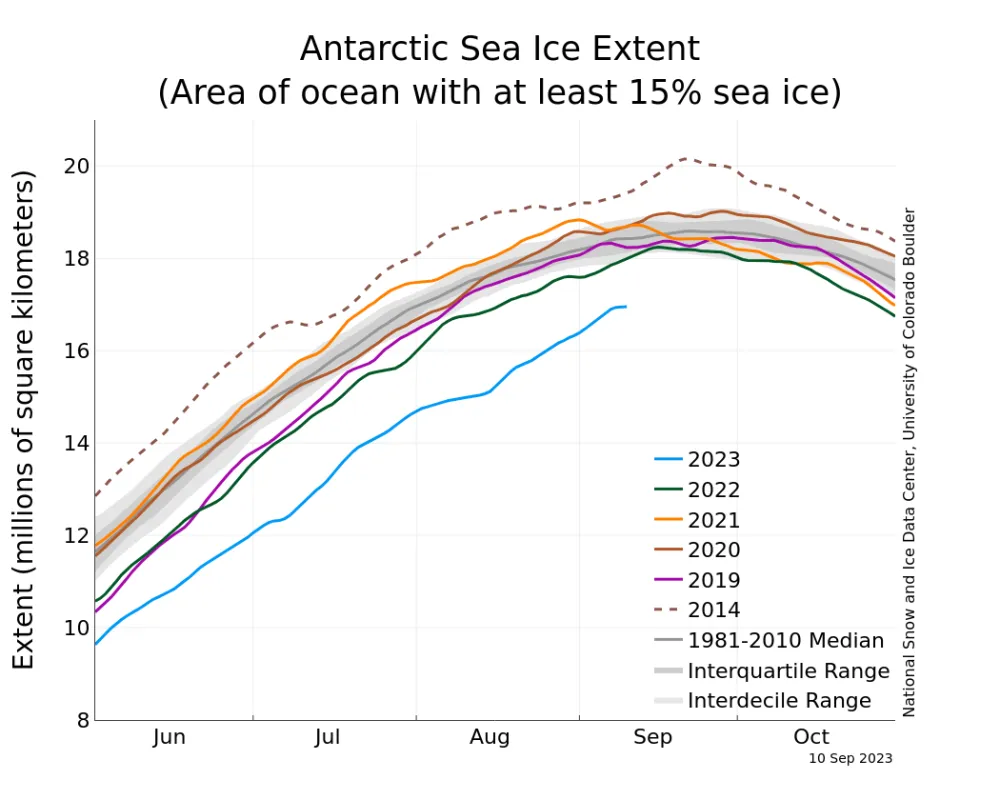On September 10, Antarctic sea ice likely reached its annual maximum extent of 16.96 million square kilometers (6.55 million square miles). This is the lowest sea ice maximum in the 1979 to 2023 sea ice record by a wide margin.
Please note that this is a preliminary announcement. Changing winds or late-season growth could still increase the Antarctic ice extent. NSIDC scientists will release a full analysis of the Antarctic and Arctic September conditions in early October.
Overview of conditions
On September 10, 2023, sea ice in the Antarctic reached an annual maximum extent of 16.96 million square kilometers (6.55 million square miles), setting a record low maximum in the satellite record that began in 1979 (Figure 1). This year’s maximum is 1.03 million square kilometers (398,000 square miles) below the previous record low set in 1986. It is also 1.75 million square kilometers below (676,000 square miles) below the 1981 to 2010 average Antarctic maximum extent. Sea ice extent is markedly below average north of Queen Maud Land and west of the Antarctic Peninsula. Other low areas include the Indian Ocean and Ross Sea. Extent is above average stretching out of the Amundsen Sea.
The Antarctic maximum extent is one of the earliest on record, having reached it 13 days earlier than the 1981 to 2010 median date of September 23. The interquartile range for the date of the Antarctic maximum is September 18 to September 30.
Conditions in context
This year marks a significant record low maximum in Antarctic sea ice extent (Figure 2). Since early April 2023, sea ice maintained record low ice growth. From early to mid-August, growth slowed considerably, maintaining a difference of nearly 1.5 million square kilometers (579,000 square miles) between 2023 and 1986, the second lowest year on satellite record. After that period, ice growth quickened and narrowed the gap to about 1 million square kilometers (386,000 square miles). This is the first time that sea ice extent has not surpassed 17 million square kilometers (6.56 million square miles), falling more than one million square kilometers below the previous record low maximum extent set in 1986.
Ten lowest maximum Antarctic sea ice extents (satellite record, 1979 to present)
| RANK | YEAR | MAXIMUM ICE EXTENT | DATE | |
|---|---|---|---|---|
| IN MILLIONS OF SQUARE KILOMETERS | IN MILLIONS OF SQUARE MILES | |||
| 1 | 2023 | 16.96 | 6.55 | Sept. 10 |
| 2 | 1986 | 17.99 | 6.95 | Sept. 21 |
| 3 | 2002 | 18.05 | 6.97 | Oct. 12 |
| 4 | 2017 | 18.10 | 6.99 | Oct. 10 |
| 5 | 1989 2022 2018 2008 | 18.22 18.25 18.25 18.26 | 7.03 7.05 7.05 7.05 | Sept. 25 Sept. 16 Oct. 03 Sept. 06 |
| 9 | 1984 1979 | 18.32 18.34 | 7.07 7.08 | Sept. 23 Sept. 16 |
Values within 40,000 square kilometers (15,000 square miles) are considered tied.
References
Purich, A. and E. W. Doddridge. 2023. Record low Antarctic sea ice coverage indicates a new sea ice state. Communications Earth and Environment 4, 314, doi:10.1038/s43247-023-00961-9.
Turner, J., T. Phillips, G. J. Marshall, J. S. Hosking, J. O. Pope, T. J. Bracegirdle, and P. Deb. 2017. Unprecedented springtime retreat of Antarctic sea ice in 2016. Geophysical Research Letters, 44(13), 6868-6875, doi:10.1002/2017GL073656.
Turner, J., C. Holmes, T. Caton Harrison, T. Phillips, B. Jena, T. Reeves‐Francois, R. Fogt, E. R. Thomas, C. C. and Bajish. 2022. Record low Antarctic sea ice cover in February 2022. Geophysical Research Letters, 49(12), e2022GL098904, doi:10.1029/2022GL098904.
Zhang, L., T. L. Delworth, X. Yang, F. Zeng, F. Lu, Y. Morioka, and M. Bushuk. 2022. The relative role of the subsurface Southern Ocean in driving negative Antarctic Sea ice extent anomalies in 2016–2021, 3, 302, Communications Earth and Environment doi:10.1038/s43247-022-00624-1.
For more information
NASA visualization of 2023 Arctic sea ice minimum extent

